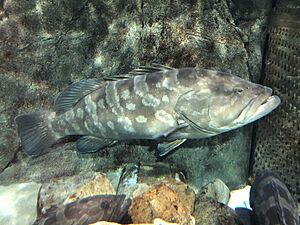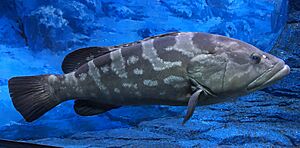Longtooth grouper facts for kids
Quick facts for kids Longtooth grouper |
|
|---|---|
 |
|
| Conservation status | |
| Scientific classification | |
| Synonyms | |
The longtooth grouper, also known as the kelp grouper, is a type of fish that lives in the ocean. Its scientific name is Epinephelus bruneus. This fish belongs to a group called groupers. Groupers are part of a larger family of fish called Serranidae. This family also includes fish like anthias and sea basses. You can find the longtooth grouper in the northwest Pacific Ocean, especially around eastern Asia.
Contents
What Does the Longtooth Grouper Look Like?
The longtooth grouper has a body that is longer than it is deep. Its head is slightly rounded between its eyes. It has a special bone near its gills called the preopercle. This bone has some larger, jagged edges. There is also a small spine on the upper part of its gill cover.
This fish has two main fins on its back and belly. The fin on its back, called the dorsal fin, has 11 stiff spines and 13 to 15 soft rays. The fin on its belly, called the anal fin, has 3 spines and 8 soft rays. It also has a line of scales along its side, called the lateral line, with 64 to 72 scales.
Adult longtooth groupers are usually dark grayish-brown. They might have faint spots on their backs. Sometimes, these spots are not visible at all. Their bodies are covered in small gray spots. These spots often form short lines, making a mottled or patchy pattern. The bottom edge of their anal fin and the lower corner of their tail fin are white.
Young longtooth groupers, called juveniles, look different. They are pale yellowish-brown. They have 6 dark, slanted stripes on their bodies. Inside these dark stripes, there are irregular pale spots. The first stripe goes from their neck to their eye. The last stripe is on their tail base. They also have three dark brown lines that spread out from the lower part of their eye. Some young fish have greenish-yellow skin between the back spines of their dorsal fin.
The biggest longtooth grouper ever found was about 136 centimeters (53 inches) long. However, most of them are around 60 centimeters (24 inches) long. The heaviest one recorded weighed about 33 kilograms (73 pounds).
Where Does the Longtooth Grouper Live?
The longtooth grouper lives in the Western Pacific Ocean. You can find it in places like southern Japan and Taiwan. It also lives along the coast of Asia. This includes southern Korea and down to Hainan and Hong Kong in southern China. Scientists are still studying exactly where different types of this fish live.
Habitat and Biology
Longtooth groupers like to live near rocky reefs. They also live in areas with muddy bottoms. Adult fish are usually found in deeper waters, from about 20 to 200 meters (66 to 656 feet) deep. They can also be found around coral reefs and man-made structures like artificial reefs.
Young longtooth groupers prefer shallower water. They live in water less than 5 meters (16 feet) deep. We don't know a lot about the daily lives and habits of this fish. Scientists are still learning more about them.
How Scientists Study and Name This Fish
The longtooth grouper was first officially described in 1793. A German doctor and naturalist named Marcus Elieser Bloch gave it its scientific name. He thought it was found in Norway, but that was a mistake. It was actually found in China.
Some scientists believe there might be two different types of Epinephelus bruneus. They think there's E. bruneus and another similar fish called E. moara. Scientists are still working to figure out exactly where each of these types of fish lives. E. moara seems to be found in Japan, Korea, Taiwan, and parts of China.
How People Use the Longtooth Grouper
The longtooth grouper is considered a very good fish to eat. People catch it using different fishing methods. These include hand lines, which are simple fishing lines held by hand. They also use longlines, which are very long lines with many hooks. Sometimes, they are caught using trawls, which are large nets pulled behind boats.



